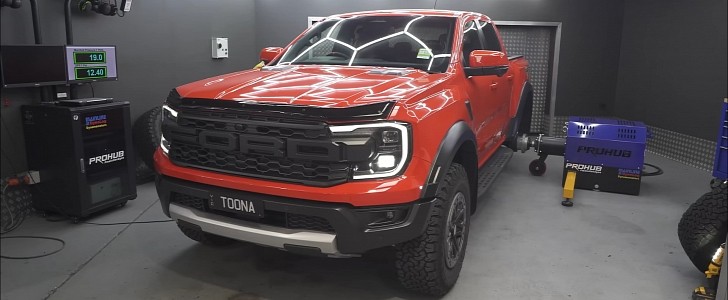The most powerful Ranger Raptor of them all features a 3.0-liter V6. Shared with the Bronco Raptor, the force-fed lump develops 284 horsepower and 362 pound-foot (491 Nm) in European markets and the United Kingdom. The Australia-spec Ranger Raptor, on the other hand, levels up to 392 horsepower and 430 pound-foot (583 Nm) at the crank.
Pretty good numbers for a six-cylinder engine in a mid-sized pickup, but how many of those ponies actually get to the wheels? FullBOOST is much obliged to answer that question with the help of the roller and hub dynos at MAXX Performance. Performed in rear-wheel drive and seventh gear, the very first run ended with 190.7 kW and 360 Nm (256 hp and 266 lb-ft).
Switching to four-wheel drive and sixth gear on the roller dyno results in 214.9 kW and 472.9 Nm (288 hp and 349 lb-ft), which is “not normal,” according to Zane of MAXX Performance. “The problem with the standard car is that it’s limited to 188 kilometers per hour (nearly 117 miles per hour),” added Zane, which results in “a speed cut at about 5,800 rpm.”
The all-terrain rubber boots don’t help either, which is why the boys then switch to the hub dyno for slightly better numbers. In sixth gear and rear-wheel drive, the Ranger Raptor channeled no fewer than 267.3 kW (358.4 hp) to the rear wheels at best. After making a single modification to the air intake box, the go-anywhere pickup laid down 267.4 kW (358.6 hp).
Switching the OEM air filter with a performance air filter doesn’t yield any higher numbers. When all is said and done, there’s no denying that Ford made the right call to ditch the 2.0-liter EcoBlue four-cylinder turbo diesel for the 3.0-liter EcoBoost V6 twin-turbo gasoline for the second generation of the Ranger Raptor. Not long now, the Ranger Raptor – with this exact same engine – will be coming stateside, most likely for the 2024 model year.
Switching to four-wheel drive and sixth gear on the roller dyno results in 214.9 kW and 472.9 Nm (288 hp and 349 lb-ft), which is “not normal,” according to Zane of MAXX Performance. “The problem with the standard car is that it’s limited to 188 kilometers per hour (nearly 117 miles per hour),” added Zane, which results in “a speed cut at about 5,800 rpm.”
The all-terrain rubber boots don’t help either, which is why the boys then switch to the hub dyno for slightly better numbers. In sixth gear and rear-wheel drive, the Ranger Raptor channeled no fewer than 267.3 kW (358.4 hp) to the rear wheels at best. After making a single modification to the air intake box, the go-anywhere pickup laid down 267.4 kW (358.6 hp).
Switching the OEM air filter with a performance air filter doesn’t yield any higher numbers. When all is said and done, there’s no denying that Ford made the right call to ditch the 2.0-liter EcoBlue four-cylinder turbo diesel for the 3.0-liter EcoBoost V6 twin-turbo gasoline for the second generation of the Ranger Raptor. Not long now, the Ranger Raptor – with this exact same engine – will be coming stateside, most likely for the 2024 model year.


























